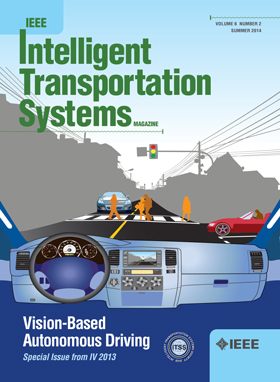Semantic-MoSeg: Semantics-Assisted Moving-Obstacle Segmentation in Bird-Eye-View for Autonomous Driving
IF 8.4
1区 工程技术
Q1 ENGINEERING, CIVIL
IEEE Transactions on Intelligent Transportation Systems
Pub Date : 2025-06-03
DOI:10.1109/TITS.2025.3570058
引用次数: 0
Abstract
Bird-eye-view (BEV) perception for autonomous driving has become popular in recent years. Among various BEV perception tasks, moving-obstacle segmentation is very important, since it can provide necessary information for downstream tasks, such as motion planning and decision making, in dynamic traffic environments. Many existing methods segment moving obstacles with LiDAR point clouds. The point-wise segmentation results can be easily projected into BEV since point clouds are 3-D data. However, these methods could not produce dense 2-D BEV segmentation maps, because LiDAR point clouds are usually sparse. Moreover, 3-D LiDARs are still expensive to vehicles. To provide a solution to these issues, this paper proposes a semantics-assisted moving-obstacle segmentation network using only low-cost visual cameras to produce segmentation results in dense 2-D BEV maps. Our network takes as input visual images from six surrounding cameras as well as the corresponding semantic segmentation maps at the current and previous moments, and directly outputs the BEV map for the current moment. We also propose a movable-obstacle segmentation auxiliary task to provide semantic information to further benefit moving-obstacle segmentation. Extensive experimental results on the public nuScenes and Lyft datasets demonstrate the effectiveness and superiority of our network.语义- moseg:自动驾驶鸟瞰图中语义辅助移动障碍物分割
近年来,用于自动驾驶的鸟瞰图(BEV)感知技术越来越受欢迎。在各种纯电动汽车感知任务中,运动障碍物分割是非常重要的,因为它可以为动态交通环境下的下游任务(如运动规划和决策)提供必要的信息。现有的许多方法都是利用激光雷达点云对移动障碍物进行分割。由于点云是三维数据,逐点分割结果可以很容易地投影到BEV中。然而,由于LiDAR点云通常是稀疏的,这些方法不能产生密集的二维BEV分割地图。此外,3d激光雷达对车辆来说仍然很昂贵。为了解决这些问题,本文提出了一种语义辅助的移动障碍物分割网络,仅使用低成本的视觉摄像机在密集的二维BEV地图中产生分割结果。我们的网络将周围6台摄像机的视觉图像以及对应的当前时刻和之前时刻的语义分割图作为输入,直接输出当前时刻的BEV图。我们还提出了一个移动障碍物分割辅助任务,为进一步的移动障碍物分割提供语义信息。在公共nuScenes和Lyft数据集上的大量实验结果证明了我们的网络的有效性和优越性。
本文章由计算机程序翻译,如有差异,请以英文原文为准。
求助全文
约1分钟内获得全文
求助全文
来源期刊

IEEE Transactions on Intelligent Transportation Systems
工程技术-工程:电子与电气
CiteScore
14.80
自引率
12.90%
发文量
1872
审稿时长
7.5 months
期刊介绍:
The theoretical, experimental and operational aspects of electrical and electronics engineering and information technologies as applied to Intelligent Transportation Systems (ITS). Intelligent Transportation Systems are defined as those systems utilizing synergistic technologies and systems engineering concepts to develop and improve transportation systems of all kinds. The scope of this interdisciplinary activity includes the promotion, consolidation and coordination of ITS technical activities among IEEE entities, and providing a focus for cooperative activities, both internally and externally.
 求助内容:
求助内容: 应助结果提醒方式:
应助结果提醒方式:


